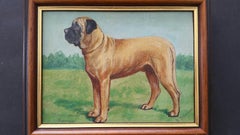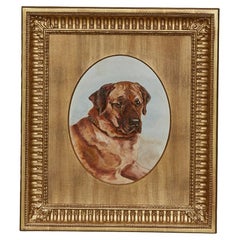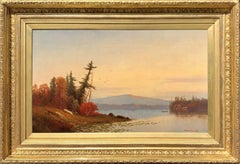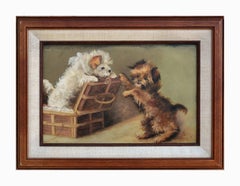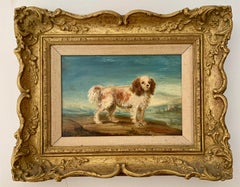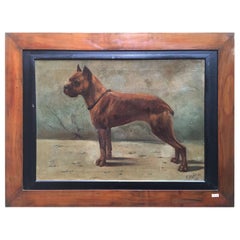Mastiff Oil Painting
English School Mid 20th Century Oil Painting Mastiff Broomcourt Romeo Dog
By Dorothy Alexandra Johnson
Located in Cirencester, Gloucestershire
Mastiff: "Broomcourt Romeo"
by Dorothy Alexandra Johnson (1902-1988)
signed lower right
oil
Category
1950s Impressionist Animal Paintings
Materials
Oil
H 5.5 in W 7.25 in D 0.1 in
English 19th Century Oil on Board Mastiff Dog Painting in Giltwood Frame
Located in Atlanta, GA
An English oil on board painting from the 19th century depicting the bust of a mastiff dog, in
Category
Antique 19th Century English Paintings
Materials
Wood
"In One Ear, Out the Other, " Oil Painting
Located in Denver, CO
MJ Lindo's "In One Ear, Out the Other" is an original, handmade oil painting that depicts a woman
Category
2010s Contemporary Portrait Paintings
Materials
Oil, Wood Panel
English Victorian 19th century portrait of a brown and white Spaniel dog
By George Earl
Located in Woodbury, CT
exhibited nineteen paintings at the Royal Academy between 1857 and 1882, although only two were of dogs (a
Category
1850s Victorian Animal Paintings
Materials
Canvas, Oil
Free Shipping
H 25.5 in W 6.5 in
Sunset on the Hudson River by Hermann Simon (American, 1846-1895)
Located in New York, NY
oil on canvas, measures 15 x 25 inches, and is signed and dated 1875 at the lower right. The work is
Category
19th Century Hudson River School Landscape Paintings
Materials
Canvas, Oil
People Also Browsed
Late 19th Century Cairn Terrier Puppies, Dog Portrait
By Katherine L Fitz
Located in Soquel, CA
Charming 19th-century painting of two Cairn Terrier puppies playing in sewing basket by Katherine L. Fitz (American, 19th Century). Written on verso, "Painter M. Fitz Oakland, Cal. O...
Category
Late 19th Century American Impressionist Animal Paintings
Materials
Cardboard, Oil
English 19th century folk art portrait of an English spaniel dog in a landscape
Located in Woodbury, CT
English 19th century folk art portrait of an English spaniel dog in a landscape.
Painted with a great deal of skill and care this is a charming 19th-century piece.
With the origin...
Category
1840s Folk Art Animal Paintings
Materials
Oil, Board
Free Shipping
H 11 in W 14 in
Bayou Belle
By Hunt Slonem
Located in Boston, MA
Artist: Slonem, Hunt
Title: Bayou Belle
Date: 2023
Medium: Oil on Panel
Unframed Dimensions: 15" x 20.5"
Framed Dimensions: 26.5" x 32"
Signature: Signed Verso
Edition: Unique...
Category
2010s Contemporary Paintings
Materials
Oil
oil on canvas portrait of a little dog by Ferdinand Krumholz
Located in Gavere, BE
Beautiful old oil painting ,depicting the portrait of a little dog , oil on canvas . ( ca 1850 ) Austrian school late 19th
Ferdinand Krumholz was a Austrian visual artist who was bo...
Category
1860s Other Art Style Animal Paintings
Materials
Canvas, Oil
Free Shipping
H 20.87 in W 17.72 in D 2.76 in
A Hunter with his Dogs
Located in St. Albans, GB
Gaston Le Sargeant De MONNECOVE
Oil on Canvas
Picture Size : 18 x 24" (46 x 61cm)
Outside Frame Size: 26 x 32" (66 x 81cm)
A classic example of De Monnecove's work capturing French ...
Category
1890s French School Landscape Paintings
Materials
Oil
Portrait of Lady Caroline Price
By George Romney
Located in Miami, FL
DESCRIPTION: Perhaps the best Romney in private hands. If Vogue Magazine existed in the late 18th century, this image of Lady Caroline Price would be on one of its covers. The e...
Category
1970s Old Masters Portrait Paintings
Materials
Canvas, Oil
Horse portrait oil painting of a bay stallion
By Henry Frederick Lucas Lucas
Located in Moreton-In-Marsh, Gloucestershire
Henry Frederick Lucas Lucas
British, (1848 1943)
Boatswain (Bo’sun)
Oil on canvas, signed & dated 1900, further inscribed verso
Image size: 19.5 inches x 25.5 inches
Size including...
Category
Late 19th Century Victorian Animal Paintings
Materials
Oil, Canvas
H 26 in W 32 in D 2 in
English 19th century portrait of two seated King Charles Cavalier Spaniels dogs
By James Cassie
Located in Woodbury, CT
James Cassie was born at Keithhall near Inverurie, Aberdeenshire, the son of a prosperous tea and spirit merchant. Although briefly a pupil of the artist James Giles, Cassie was larg...
Category
1850s Victorian Animal Paintings
Materials
Oil, Wood Panel
Free Shipping
H 14.5 in W 16.5 in
19th Century pair of still life oil paintings of fruit and flowers
By Oliver Clare
Located in Moreton-In-Marsh, Gloucestershire
***PLEASE NOTE: EACH PAINTING INCLUDING THE FRAME MEASURES 13 INCHES X 16 INCHES***
Oliver Clare
British, (1853-1927)
Still Life of Fruit & Still Life of Flowers
Oil on canvas, pair...
Category
19th Century Victorian Still-life Paintings
Materials
Oil, Canvas
H 13 in W 16 in D 3 in
Whimsical English 19th-20th Century White Marble Figural Outdoor Dog Fountain
Located in Los Angeles, CA
A Whimsical English 19th-20th century white marble figural fountain with dogs fountain. The Baroque Revival six-sided tripod marble base surmounted with three upright seated Yorkshir...
Category
Antique Early 1900s English Baroque Revival Fountains
Materials
Marble
H 60.63 in W 30.5 in D 28.5 in
'Prime Minister' with jockey John Shepherd up, and owner Sir Mark Sykes
By Henry Bernard Chalon
Located in Stoke, Hampshire
Henry Bernard Chalon (London 1770-1849)
'Prime Minister' with jockey John Shepherd up, and owner Sir Mark Sykes
Signed and dated 'H.B. Chalon pinxit 1814' lower centre
Oil on canvas
...
Category
Early 19th Century Old Masters Animal Paintings
Materials
Oil
Antique oil painting, Boy Fleaing a Dog, Gerard ter Borch, Dutch golden age
Located in DEVENTER, NL
Gerard ter Borch (II) (1617-1681), copy after, around 1700
'Boy Fleaing a Dog'
Oil on canvas
Professionally restored (cleaned and relined)
In modern frame in 17th century style
Dime...
Category
Early 18th Century Old Masters Interior Paintings
Materials
Oil, Canvas
Antique Dog Painting; Cavalier King Charles Gustav Lorincz (Austrian, 1855-1931)
Located in SANTA FE, NM
Antique Dog Painting of a Cavalier King Charles
Gustav Lorincz (Austrian, 1855-1931)
Oil on panel, signed
9 1/4 x 6 3/4 (13 3/4 x 11 1/4 frame) inches
Gustav Lorincz was a noted...
Category
Early 1900s Realist Animal Paintings
Materials
Canvas, Oil
H 11.25 in W 13.75 in D 2.5 in
Portrait of a Yawning Dachshund - Animal 1915 art oil painting
Located in London, GB
Is there anything more cute than a dog yawning? Especially a gorgeous little Dachshund? I think not. Painted in 1915 and signed G A C, this super little painting is a profile view o...
Category
1910s Realist Animal Paintings
Materials
Oil
Rosenthal Porcelain Figurine Of A Fox Terrier Dog
By Rosenthal
Located in Guaynabo, PR
This is a Rosenthal porcelain figurine of a dog. It depicts a very well done hand painted white, brown and black Fox Terrier dog. He is standing up with a sweet gaze trying to tell y...
Category
20th Century German Mid-Century Modern Animal Sculptures
Materials
Porcelain
Giltwood Framed Oil on Canvas Dog Painting by Charles Van den Eycken
Located in Atlanta, GA
A Belgian framed oil on canvas painting by Charles Van den Eycken (1859 – 1923), depicting two dogs in an interior. Created in Belgium during the second half of the 19th century, thi...
Category
Antique 19th Century Belgian Paintings
Materials
Canvas, Giltwood, Paint
Recent Sales
Albert Clark Oil on Canvas
Located in Stockholm, SE
Mastiff- Oil on canvas. Signed : Albert Clark 1890. Albert Clark ,English artist 1821-1909. 90% of
Category
Antique 1890s English Paintings
French Dog Painting of Mastiff Boxer Signed Dated Fr Naas 1923 Framed
Located in Milan, IT
Oil painting on canvas depicting a mastiff dog, a boxer with striped and dark coat, represented
Category
Vintage 1920s French Paintings
Materials
Walnut, Canvas
French Boxer Dog Painting by Fr Naas 1923 Oil on Canvas with Walnut Frame
Located in Milan, IT
Oil painting on canvas depicting a mastiff dog, a boxer with striped and dark coat, represented
Category
Vintage 1920s French Paintings
Materials
Canvas, Walnut
H 29.14 in W 37.8 in D 1.19 in
English Victorian 19th century portrait of a smooth coated St.Bernard dog
By George Earl
Located in Woodbury, CT
exhibited nineteen paintings at the Royal Academy between 1857 and 1882, although only two were of dogs (a
Category
1860s Victorian Animal Paintings
Materials
Oil
Free Shipping
H 25.5 in W 25.5 in
"Portrait of Two Dogs, " 1873 by Clara von Wille (German, 1838-1883)
Located in SANTA FE, NM
"Portrait of Two Dogs", 1873
Clara von Wille (German, 1838-1883)
Oil on canvas
Signed and dated
Category
1870s Academic Animal Paintings
Materials
Cotton Canvas, Oil
Pair of Portraits of Children and their Dogs
Located in Montreal, QC
Portraits of children posed in fanciful scenes ; the girl on a lakeside path with her mastiff; the
Category
Antique 19th Century Unknown Victorian Paintings
Victorian Naive Oil on Canvas Framed Signed Portrait of a Bernard Dog
Located in STOKE ON TRENT, GB
Naïve oil on canvas framed
A Victorian Circa 1900 Signed Portrait of a St. Bernard Type Dog
A
Category
Antique 19th Century British Picture Frames
Materials
Canvas, Paint
H 26.38 in W 18.12 in D 1.19 in
Portrait Of Brindle Coasted Mastiff Sleeping, 19th Century
By John Emms
Located in Blackwater, GB
portrait of a sleeping Mastiff with a brindle coat, oil on canvas by John Emms, Excellent quality and
Category
19th Century Portrait Paintings
Materials
Canvas, Oil
"Just Watch, " Oil Painting
Located in Denver, CO
MJ Lindo's "Just Watch" is an original, handmade oil painting that depicts a woman with pink hair
Category
2010s Realist Portrait Paintings
Materials
Gouache, Wood Panel
Monumental 19th Century Signed L. Stowe Oil Painting of Dog
Located in Los Angeles, CA
This large oil painting on canvas behind glass is in the original frame. The frame has carved
Category
Antique Late 19th Century American Adirondack Paintings
Portrait of a Spaniel
By George Earl
Located in Stoke, Hampshire
George Earl (1824-1904)
Portrait of a spaniel
Signed lower right
Oil on panel
Painting size 16 x 16
Category
19th Century Victorian Animal Paintings
Materials
Oil
English Victorian 19th century portrait of a brown Dachshund dog or sausage dog
By George Earl
Located in Woodbury, CT
exhibited nineteen paintings at the Royal Academy between 1857 and 1882, although only two were of dogs (a
Category
Early 1900s Victorian Animal Paintings
Materials
Oil
Free Shipping
H 19.5 in W 19.5 in
English Victorian 19th century portrait of a Pug dog with a blue bell collar
By George Earl
Located in Woodbury, CT
exhibited nineteen paintings at the Royal Academy between 1857 and 1882, although only two were of dogs (a
Category
Early 1900s Victorian Animal Paintings
Materials
Oil
Free Shipping
H 19.5 in W 19.5 in
King Charles Spaniels
By Sir Edwin Henry Landseer, 1802-1873
Located in Stoke, Hampshire
Follower of Sir Edwin Landseer
King Charles Spaniels
Oil on canvas
Canvas size 20 x 24 in
Framed
Category
19th Century Victorian Animal Paintings
Materials
Oil
Dog Portrait of a Saint Bernard
Located in SANTA FE, NM
Dog Portrait of a Saint Bernard
British School, late 19th/early 20th century
Oil on canvas
11 3/4 x
Category
Early 20th Century Realist Animal Paintings
Materials
Canvas, Oil
Pastel Dog Portrait of a Saint Bernard 1920s
Located in SANTA FE, NM
, the monks at Great St. Bernard Hospice acquired their first St. Bernards—descendants of the mastiff
Category
1920s Realist Animal Paintings
Materials
Canvas, Oil
Get Updated with New Arrivals
Save "Mastiff Oil Painting", and we’ll notify you when there are new listings in this category.
Questions About Mastiff Oil Painting
- What is abstract oil painting?1 AnswerLilac Gallery Ltd.March 17, 2021An abstract oil painting and an artwork that is made with oil paint on a medium like canvas, wood board, or other panels like canvas board. And the 'abstract' term refers to the Movement & Style of the piece. As abstraction indicates a departure from reality in the depiction of imagery in art, the artist creates a painting where the subject, shape, form, color, and line, is created with no particular references of the world but as a composition that may exist with a degree of independence from its vision.
- 1stDibs ExpertMarch 22, 2024To maintain oil paintings that you purchased for your home, experts suggest that you keep them out of direct sunlight. Prolonged exposure to the sunlight coming in from a window can fade the colors in your painting. Do not hang your oil painting near a heat source or where it can get wet (bathrooms and kitchens are not safe for your oil painting).
You may wish to dust your oil painting so that layers of dust don’t begin to gather on its surface. This should only be considered to remove loose dust. Never spray any chemical substance on your oil painting. Do not use a damp cloth to dust your oil painting. (Again, your painting should not be exposed to moisture.)
To remove loose dust, use a soft brush that measures approximately one to two inches wide with natural-hair bristles. Do not use a dust cloth or a feather duster, as those items may catch or leave threads or feathers behind. Do not apply pressure or dust your painting for an extended period of time.
If you think that your oil painting is considerably dirty or believe that other issues may be at work, experts strongly suggest that you consult with a professional conservator.
Read about how to arrange your wall art and find oil paintings for sale on 1stDibs. - 1stDibs ExpertFebruary 13, 2024To identify an oil painting, look closely at its surface. Compared to other paintings, pieces produced in oils usually show off a variety of textures across the canvas, and the paint will appear layered on. If you're looking to determine the name, age or creator of a work, try snapping a photo with your smartphone’s camera and conducting a reverse image search online. Shop a diverse assortment of oil paintings on 1stDibs.
- When was oil paint invented?1 Answer1stDibs ExpertFebruary 27, 2024Oil paint was invented during the 7th century A.D. The earliest examples of oil paintings have been traced to Afghanistan and depict scenes related to the Buddhist religion. Records dating back to the 12th century indicate that early Christian monks in Europe used oil paints to decorate furniture, and a century later, some artists began finishing tempera paintings with touches of oil paint. It wasn't until the 15th century that oil paints became a common medium for European painters, when Flemish artists like Jan van Eyck began favoring them over tempera. Explore a variety of oil paintings on 1stDibs.
- 1stDibs ExpertMay 3, 2024Jan van Eyck is widely considered by art historians to be the father of oil painting. While the usage of oil paints dates back to 7th-century China, the Flemish painter popularized the material, using oils to produce highly detailed works such as The Arnolfini Portrait. The Northern Renaissance master also influenced many other artists, such as Hugo van der Goes and Gerard David. Shop an assortment of fine art on 1stDibs.
- Did Dali use oil paint?1 Answer1stDibs ExpertApril 5, 2022Yes, Dali did indeed use oil paint. Although he used oil paints in the traditional method, he would at times add natural resin or linseed oil to play with fluidity and texture. You can shop a selection of Salvador Dali’s pieces from some of the world’s top art dealers on 1stDibs.
- Can you use oil paint on wood?1 Answer1stDibs ExpertFebruary 22, 2021You can use oil paint on wood as long as you prep the wood first. The first thing you should do is seal the wood with a primer. Ideally, paint two coats of sealer onto the wood so that the paint doesn't cause the wood to rot over time.
- 1stDibs ExpertApril 5, 2022The largest oil painting in the world is in the main hall of the Doge's Palace located in Venice, Italy. Its name is Il Paradiso. Tintoretto painted it around 1592, and it measures 22 meters by 7 meters. Shop a large collection of oil paintings on 1stDibs.
- 1stDibs ExpertSeptember 25, 2019
Varnishing an oil is not necessary, but it is recommended because it protects the painting and corrects surface irregularities.
- 1stDibs ExpertApril 5, 2022To find the artist of an oil painting, look on the back of the canvas. Sometimes, you will find the artist’s name and the year of production on the back. If the canvas is in a frame, gently peel away the paper covering the back to access the canvas. In the event you cannot find any identifying information, seek the help of a licensed art appraiser. Shop a selection of oil paintings on 1stDibs.
- La ChrysomeleFebruary 24, 2021Any artwork is worth and only worth the price someone is willing to pay for it (unfortunately, whether one can afford it or not is another story). Different people may have different reasons to attribute value to an artwork, from the purest (falling in love with it) to what is often considered as the most vile (speculation), going through remembrance, pride of ownership, or brag, among other reasons. For most living artists, the price of the artworks is usually set by the artist and/or the gallery which represent him or her, by type and size of artwork, and corresponds to an equilibrium price between the rate at which artworks are sold and the rate at which new artworks are produced by the artist. For artworks from dead artists sold by professional dealers, the price is often based on auctions results for similar pieces of the same artists. Oil paintings are usually pricier than other techniques because it is considered more difficult to master, but also because oil paintings are known for their ability to last centuries.
- 1stDibs ExpertApril 5, 2022To tell if your oil painting is authentic, first check the signature of the artist to start your research. Use a magnifying glass to check the texture of the painting, and finally check the back for the painting’s original stretchers. Shop a selection of expertly vetted artwork from some of the world’s top art dealers on 1stDibs.
- 1stDibs ExpertFebruary 13, 2023Because the value of an oil painting can vary greatly based on the artist, the subject and the condition of the piece, it's generally best to work with a certified appraiser. A knowledgeable professional can evaluate the piece and estimate its value. Shop a variety of authentic oil paintings from some of the world’s top galleries on 1stDibs.
- 1stDibs ExpertApril 5, 2022The best place to find oil paintings and discover new artists is at local art galleries. There are also many online art dealers who provide information about artists and sell their works. On 1stDibs, you’ll discover a variety of art styles from master oil painters.
- 1stDibs ExpertMarch 22, 2024Yes, sunlight affects oil paintings. Keep your oil paintings away from direct sunlight.
To maintain oil paintings that you purchased for your home, experts suggest that you keep them out of sunlight. Prolonged exposure to the sunlight coming in from a window can fade the colors in your painting. Do not hang your oil painting near a heat source or where it can get wet (bathrooms and kitchens are not safe for your oil painting).
You may wish to dust your oil painting so that layers of dust don’t begin to gather on its surface. This should only be considered to remove loose dust. Never spray any chemical substance on your oil painting. Do not use a damp cloth to dust your oil painting. (Again, your painting should not be exposed to moisture.)
To remove loose dust, use a soft brush that measures approximately one to two inches wide with natural-hair bristles. Do not use a dust cloth or a feather duster, as those items may catch or leave threads or feathers behind. Do not apply pressure or dust your painting for an extended period of time.
If you think that your oil painting is considerably dirty or believe that other issues may be at work, experts strongly suggest that you consult with a professional conservator.
Read about how to arrange your wall art and find oil paintings for sale on 1stDibs. - How much do oil paintings cost?1 Answer1stDibs ExpertSeptember 25, 2019
On 1stdibs, oil paintings cost between $60 and $6,200,000.
- 1stDibs ExpertMarch 22, 2024Yes, oil paintings darken over time. As oil paint is made of pigment particles, the range of substances that are used as pigment in oil paint can render certain colors susceptible to aging. Slowing the aging process for an oil painting involves storing your painting properly and keeping the work out of exposed sunlight. Temperature control and humidity are also important in preserving the life of an oil painting and slowing the aging process.
To maintain oil paintings that you purchased for your home, experts suggest that you keep them out of direct sunlight. Prolonged exposure to the sunlight coming in from a window can fade the colors in your painting. Do not hang your oil painting near a heat source or where it can get wet (bathrooms and kitchens are not safe for your oil painting).
You may wish to dust your oil painting so that layers of dust don’t begin to gather on its surface. This should only be considered to remove loose dust. Never spray any chemical substance on your oil painting. Do not use a damp cloth to dust your oil painting. (Again, your painting should not be exposed to moisture.)
To remove loose dust, use a soft brush that measures approximately one to two inches wide with natural-hair bristles. Do not use a dust cloth or a feather duster, as those items may catch or leave threads or feathers behind. Do not apply pressure or dust your painting for an extended period of time.
If you think that your oil painting is considerably dirty or believe that other issues may be at work, experts strongly suggest that you consult with a professional conservator.
Read about how to arrange your wall art and find oil paintings for sale on 1stDibs. - 1stDibs ExpertMay 3, 2024A few things make an oil painting valuable. Age has a major impact on price, with pieces made over a century ago tending to fetch the highest prices. Who created the painting also matters. The more famous the artist, the higher the selling price for a painting is likely to be. Finally, the condition of the work and whether it is in its original frame will also impact how much it is worth. Find a diverse assortment of oil paintings on 1stDibs.
- 1stDibs ExpertSeptember 25, 2019
Oils typically command higher prices than acrylic paintings, because they generally require more skill.
- Did Cy Twombly use oil paint?1 Answer1stDibs ExpertApril 5, 2022Yes, Cy Twombly did use oil paint, although his method was quite unique. He would run his fingers in the paint to create channels, and would then use oil paint in ‘globs’. House paint overtop would then merge the paints into a completed piece. Shop a selection of Cy Twombly’s pieces from some of the world’s top art dealers on 1stDibs.
More Ways To Browse
Antique Steel Toys
Retro Wooden Spoons
Antique Pug Dogs
Gold Pug
Victorian Pug
Dachshund Dog Paintings
Antique Pug Dog
Antique Animal Bells
Framed Art Man Horse Dog
Chelsea Dogs
Antique Victorian Dog Collars
Dog Crate Used
Portrait Of A Pug
Straw Dog
Oil Paintings Of Dachshund
Used Brandy Barrels
Chevy Oil Painting
Saint Bernards Dog
